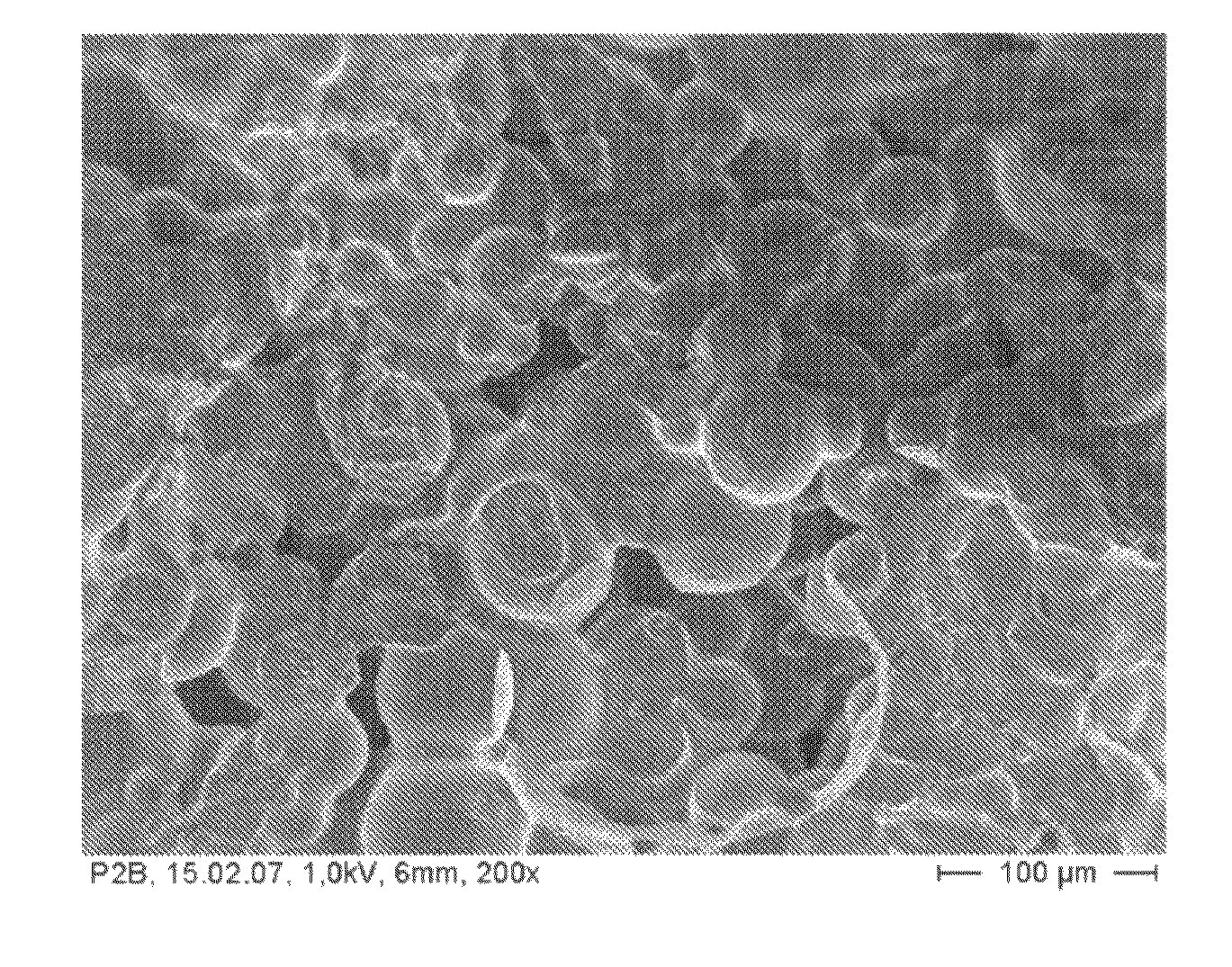Implant material based on a polymer system and the use thereof
a polymer and polymer technology, applied in the field of implants, can solve the problems of difficult homogeneous mixing, affecting and requiring corresponding manufacturing expenditures, and achieve the effect of influencing the biological, mechanical and structural properties of bone cemen
- Summary
- Abstract
- Description
- Claims
- Application Information
AI Technical Summary
Benefits of technology
Problems solved by technology
Method used
Image
Examples
example 1
[0109]Example for the principal composition of the polymer system according to the invention:[0110]a) component 1: 30 g polymer powder Degacryl® 6658 F (copolymer of PMMA and PMA (94:6) containing 1.5% BPO, particle size approximately 45 μm); 15 ml water (demineralized); 0.45 g surface-active agent (Tween 80); 0.3 g carboxymethyl starch (type PO);[0111]b) component 2: 10 ml methylmethacrylate (MMA) containing 0.5% DMPT.
[0112]Example 1 shows in a simple experiment the functional principle of the polymer system according to the invention. As a first component a commercially available polymer known from dental technology and supplied by the company Degussa (Degacryl® 6658 F) is used. This polymer is mixed with the aqueous solution of a surface-active agent—for improved miscibility of the polymer powder with the aqueous solution and subsequent mixture of the paste with the monomer liquid—and a polymer (carboxymethyl starch)—for increasing the viscosity—to a macroscopic homogenous paste....
example 2
[0116]Example for producing a bone cement according to the invention on the basis of Palacos (Heraeus-Kulzer)
[0117]Component 1: 40 g powder of the bone cement Palacos® R of the company Heraeus-Kulzer containing a mixture of PMMA / PMA copolymers, x-ray contrast agent (zirconium dioxide), and benzoyl peroxide (BPO) are mixed with 15 ml of an aqueous solution containing 2.5% surface-active agent (Tween® 80) and 2% carboxymethyl starch (type PO) to a paste. The paste is macroscopically homogeneous and will not separate under normal conditions.
[0118]Component 2: 10 ml methylmethacrylate (MMA) containing 0.5% DMPT.
[0119]Mixing of components 1 and 2 in a mixing cup. After short mixing duration with a spatula a homogeneous mixture is obtained that cures in approximately five minutes with heat development. Cylindrical shaped bodies of this mixture with the dimensions 10 mm diameter and 20 mm height achieve after incubation over night in simulated body liquid at 37° C. a compression strength o...
example 3
[0121]Implant material that after curing results in a solid with interconnected pore system:[0122]a) component 1: 30 g polymer powder Degacryl® 6658 F (copolymer of PMMA and PMA (94:6) containing 1.5% BPO, particle size approximately 45 μm); 15 ml water (demineralized); 0.45 g surface-active agent (Tween 80); 0.3 g carboxymethyl starch (type PO).[0123]b) component 2: 7 ml methylmethacrylate (MMA) containing 0.5% DMPT.
[0124]Mixing of components 1 and 2 is done in a mixing cup with a spatula. After a mixing duration of one minute a homogeneous mixture is obtained that cures in approximately five minutes with heat development. Cylindrical shaped bodies of this mixture with the dimensions 10 mm diameter and 20 mm height achieve after incubation over night in simulated body liquid at 37° C. a compression strength of 30-40 MPa.
[0125]Spherical shaped bodies of this mixture of 20 mm diameter after complete curing over night in simulated body liquid are dried in a drying cabinet at 37° C. an...
PUM
| Property | Measurement | Unit |
|---|---|---|
| shrinkage | aaaaa | aaaaa |
| temperatures | aaaaa | aaaaa |
| pH | aaaaa | aaaaa |
Abstract
Description
Claims
Application Information
 Login to View More
Login to View More - R&D
- Intellectual Property
- Life Sciences
- Materials
- Tech Scout
- Unparalleled Data Quality
- Higher Quality Content
- 60% Fewer Hallucinations
Browse by: Latest US Patents, China's latest patents, Technical Efficacy Thesaurus, Application Domain, Technology Topic, Popular Technical Reports.
© 2025 PatSnap. All rights reserved.Legal|Privacy policy|Modern Slavery Act Transparency Statement|Sitemap|About US| Contact US: help@patsnap.com



